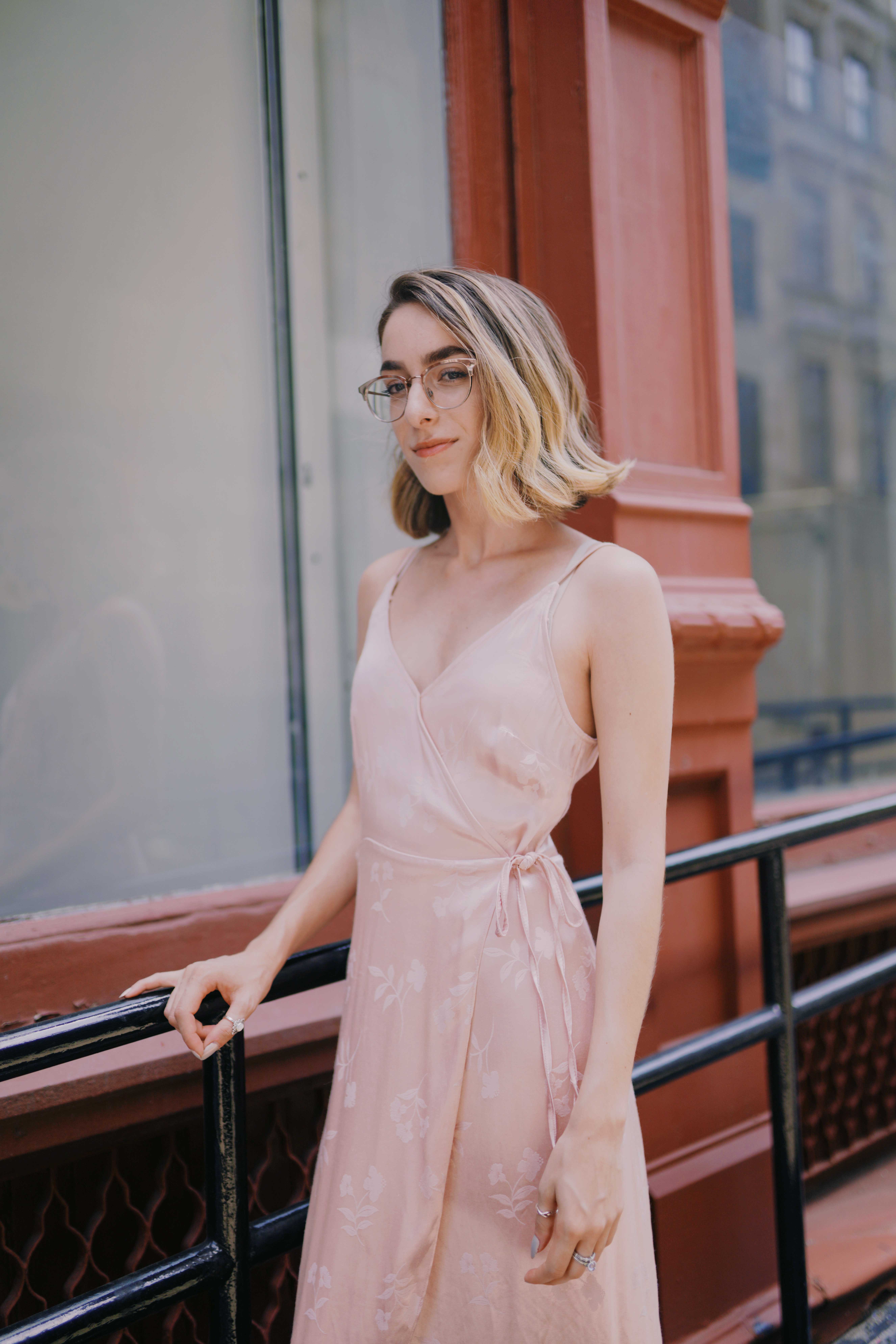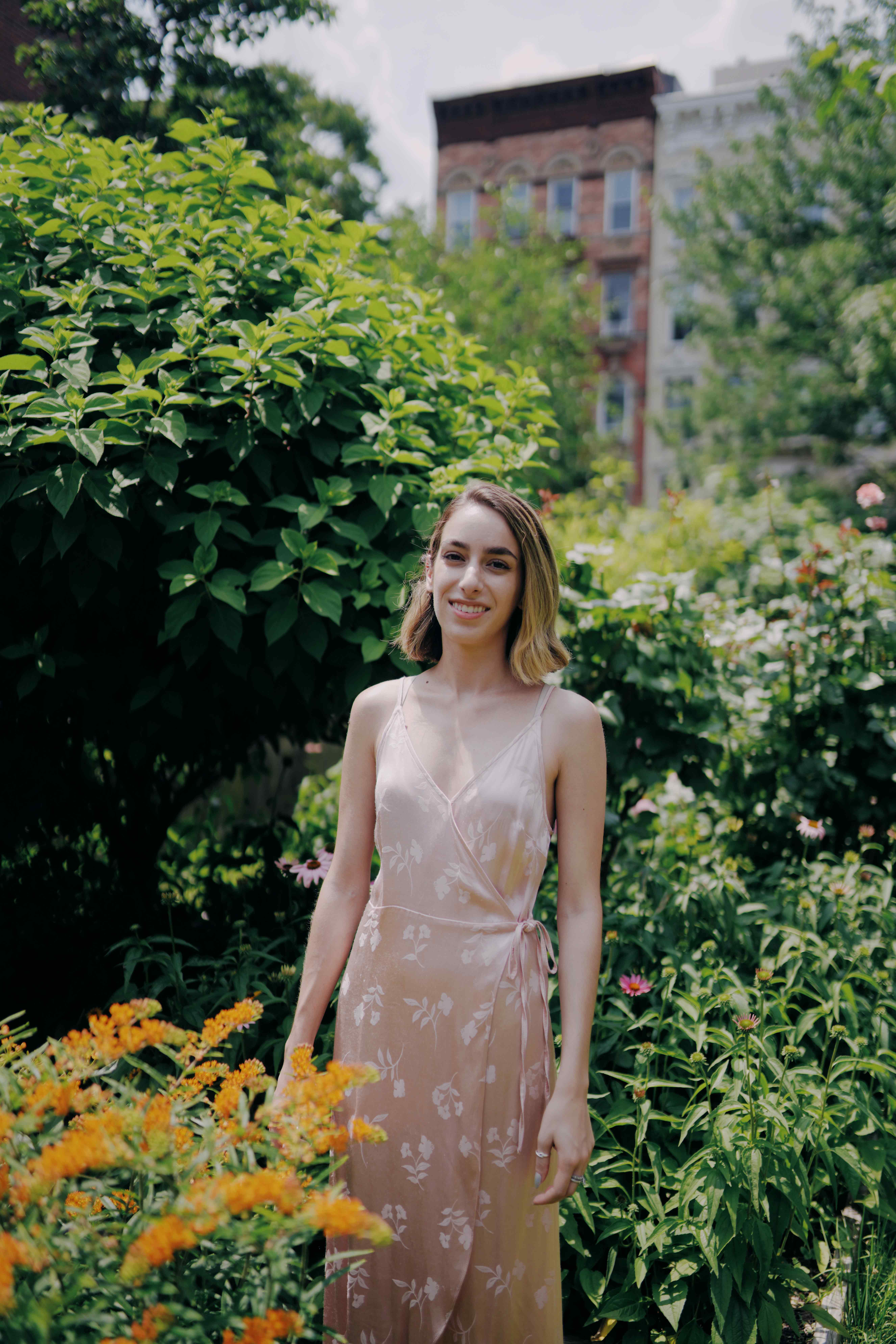
ALEXIS ZERAFA AUGMENTS REALITY
The digital effects creator on releasing the “halo” series, altering our faces, finding her niche.
Words by Tierney Finster
Photos by Kofi Dua
Playing with filters on Instagram can be a lot of fun. Afterall, who doesn’t want to look virtually sunburnt, freckled or likened to a kitty cat from time to time?
Alexis Zerafa (@AlexisZerafa) is an augmented reality effects creator based in New York. For her, the real fun lies in designing AR effects for the rest of us to use. Zerafa is part of the Spark AR Community, a beta program that provides creators the opportunity to create their own effects for Instagram and share them with their followers.
Since joining in the spring, Zerafa has produced Instagram filters including: “frog face,” “prismatic,” “crystalline crown,” “golden hour growth,” “planned iridescence,” “split spheres,” “brushed away,” “Moms 80s T shirts,” “polka dog” and “emoji expressions.”
Quite the variety, right?
This morning, Zerafa launched a trio of new effects called the “HALO” series, all inspired by TRASH's own psychedelic futurist aesthetic. She says the HALO effects invite users to “explore their whimsical and angelic side.”
Personally, I want everyone to know I’m 100% angel, so I’m totally in!
Follow Zerafa and click these links to unlock her HALO series: the basic halo, the glitch halo and the drippy halo.
Below, she tells TRASH all about studying digital media, making her favorite effects and using Instagram to bring AR to the masses.
THANK YOU FOR BEING A TRASH ANGEL. WILL YOU TELL US ABOUT A MOMENT THAT MADE YOU FEEL LIKE YOU “EARNED YOUR HALO?”
I always thought my art was something I should keep to myself, so my halo moment ties into my experience realizing you don’t always have to do that. I used to always utilize creative mediums as a personal outlet, not necessarily something I thought I needed to share with people.
Then as a student, I made a wearable app combination intended to decrease stress and anxiety - a ring you hold your phone over. A visual of a flower comes up and the flower furls and unfurls to a tempo you’re supposed to match your breathing, which is one of the best ways to get out of your own head.
When I had that prototype out, my professor sent it around and I got an email from someone who used it without me directly sharing it with them. They expressed that it really helped them and knowing I made someone’s day better, if incrementally, was a really big deal to me.

HOW DID YOU BECOME INTERESTED IN AUGMENTED REALITY?
I grew up in Michigan but I moved to New York about five years ago to go to NYU, where I studied integrated digital media. My program involved front-end coding, digital production, audio engineering, graphic design, user experience and more. We got to figure out what we’re really interested in through studying so many different disciplines. I also worked all the way through university and had several internships, each with different job functions, so that helped me directionally too.
I took a graduate-level class in augmented reality as an undergrad, but I didn’t consider it a career path because it was so new. Then I worked for an advertising agency for a little bit, which was my first time ever producing augmented reality work for a job. Creating Snapchat filters for advertising was my first go at the medium in a more corporate, commercial way. I realized augmented reality ties together so many elements of what I studied – video editing to make textures, coding and more. It keeps all my skills tethered and afloat in one place.
I grew up in Michigan but I moved to New York about five years ago to go to NYU, where I studied integrated digital media. My program involved front-end coding, digital production, audio engineering, graphic design, user experience and more. We got to figure out what we’re really interested in through studying so many different disciplines. I also worked all the way through university and had several internships, each with different job functions, so that helped me directionally too.
I took a graduate-level class in augmented reality as an undergrad, but I didn’t consider it a career path because it was so new. Then I worked for an advertising agency for a little bit, which was my first time ever producing augmented reality work for a job. Creating Snapchat filters for advertising was my first go at the medium in a more corporate, commercial way. I realized augmented reality ties together so many elements of what I studied – video editing to make textures, coding and more. It keeps all my skills tethered and afloat in one place.
TRASH IS SO LUCKY TO HAVE COLLABORATED WITH YOU ON THE HALO SERIES! WILL YOU TELL US ABOUT EACH OF THE THREE EFFECTS YOU MADE?
The first of the series, the basic HALO is exactly what it sounds like, a minimal dark halo and gentle face illumination, and when tapped the halo flips to a light airy color scheme.
The glitch HALO is a fun play on the different visual outputs that can result from issues with digital and video mediums. Part of the face is obscured by an almost opalescent glitchy facade, and plays on the moire effect and digital glitch patterns.
The drippy HALO features two options as well, the first being a surreal splash of translucent liquid on the face and a halo with purple blobs dripping out of it. The second option is a fully saturated and slightly translucent pink color scheme,transforming the splash pattern into a visual reminiscent of rainbows refracting off of water.
Each of these effects was so fun to make and refine, and I really enjoy working with colorful and bright concepts that are holographic and iridescent-inspired. Making a series is always an interesting exercise because the three effects have to communicate and form a narrative with one another, so that’s another interesting element I had to keep in mind while ideating.
THE HALO SERIES ASIDE, WHAT IS YOUR FAVORITE INSTAGRAM EFFECT YOU’VE EVER MADE?
Prismatic, which works really well across the app because of its small file size and gets used a lot. The prismatic filter has a really cohesive look and feel because I used just one texture for all of the assets. The world warps slightly as chromatic aberration outlines slowly gyrate around objects, and the geometric objects surrounding the face animate smoothly and change in nature if a user taps the screen.
The first of the series, the basic HALO is exactly what it sounds like, a minimal dark halo and gentle face illumination, and when tapped the halo flips to a light airy color scheme.
The glitch HALO is a fun play on the different visual outputs that can result from issues with digital and video mediums. Part of the face is obscured by an almost opalescent glitchy facade, and plays on the moire effect and digital glitch patterns.
The drippy HALO features two options as well, the first being a surreal splash of translucent liquid on the face and a halo with purple blobs dripping out of it. The second option is a fully saturated and slightly translucent pink color scheme,transforming the splash pattern into a visual reminiscent of rainbows refracting off of water.
Each of these effects was so fun to make and refine, and I really enjoy working with colorful and bright concepts that are holographic and iridescent-inspired. Making a series is always an interesting exercise because the three effects have to communicate and form a narrative with one another, so that’s another interesting element I had to keep in mind while ideating.
THE HALO SERIES ASIDE, WHAT IS YOUR FAVORITE INSTAGRAM EFFECT YOU’VE EVER MADE?
Prismatic, which works really well across the app because of its small file size and gets used a lot. The prismatic filter has a really cohesive look and feel because I used just one texture for all of the assets. The world warps slightly as chromatic aberration outlines slowly gyrate around objects, and the geometric objects surrounding the face animate smoothly and change in nature if a user taps the screen.
“Augmented reality artists are not just making bunny ears.”
HOW DOES THE SOCIAL NATURE OF INSTAGRAM FILTERS INFLUENCE YOUR APPROACH TO MAKING THEM? HOW WAS SOCIAL MEDIA IMPACTED YOUR CREATIVE PRACTICE THE MOST?
My goal in any medium is to create things that a lot of people can connect to; I don’t necessarily get gratification from people knowing I made the work. The biggest thing social media supplies that’s different than what I create on other platforms is that it’s something that becomes shared. Even if you don’t always get the attribution, my creation is touching a lot of people it never would otherwise. It’s always gratifying though. One of my favorite parts is having people message me and tell me they used one of my filters without knowing I made it.
Augmented reality is so interesting. There’s massive amounts of creativity using augmented media and this platform is pushing it into new mediums and new ways of using it. Augmented reality artists are not just making bunny ears. For example, there’s augmented reality filters that show a heart that you can place over your own heart and it will tell you all about the organ’s anatomy. This is an example of a great application of AR for medical students and more practical use cases.
Will you express the essence of your summer in a TRASH video?
WHAT’S THE MOST ESSENTIAL LESSON YOU’VE LEARNED SINCE BECOMING A CREATOR?
Don’t take feedback personally. I think that’s the most essential lesson, the one that never goes away. It’s always easy to take suggestions and feedback personally, but people are mostly just trying to help you.
Will you DESCRIBE your your CURRENT mood in a TRASH video?
WHAT’S A QUESTION YOU’D LIKE TO ASK A CREATOR?
One of my professors told me to pick a favorite medium and keep it as your baby and not utilize it in a corporate setting.
We all want to be passionate about our work, but we don’t necessarily want to apply every one of our passions to a company or make it our career because that means it'll be picked apart by other people and warped to be more profitable and less creative (potentially). How do you compartmentalize your creativity? How do you decide what to keep personal as art for yourself versus what you make for your career?
Get the TRASH app and make edits of your own.
Cargo Collective 2017 — Frogtown, Los Angele